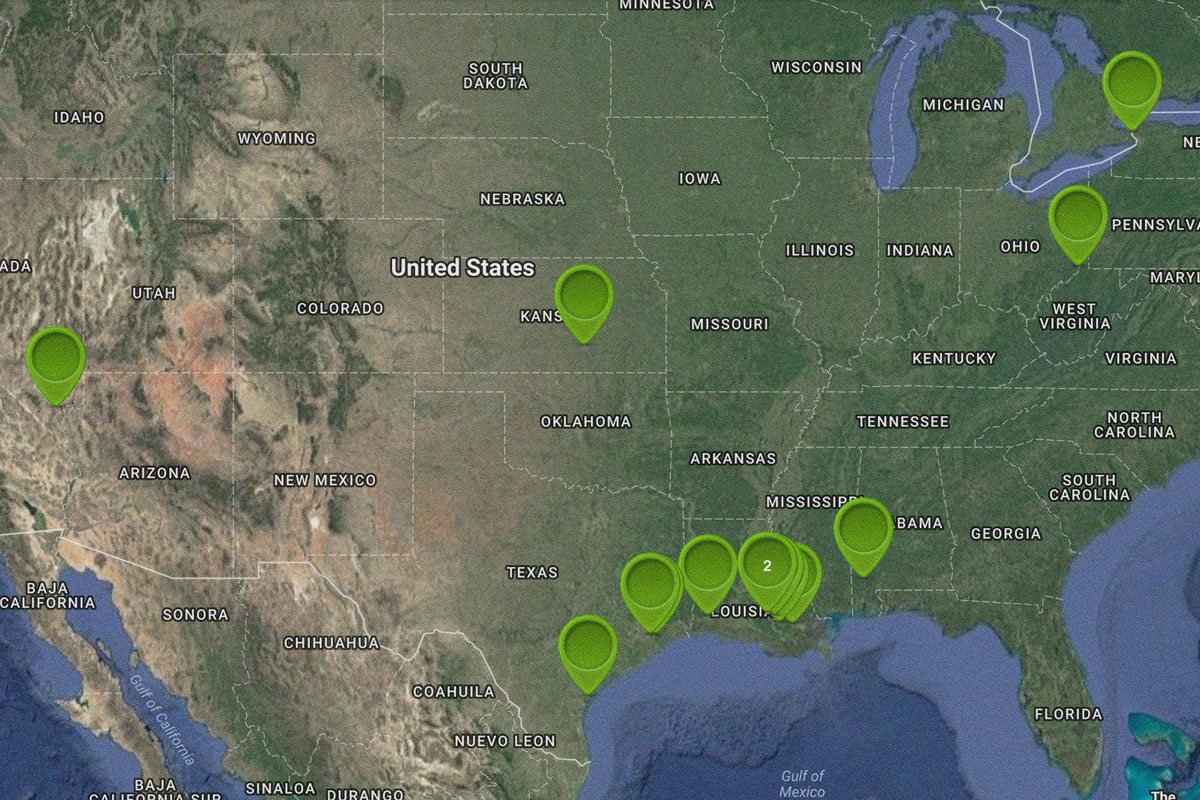 READ HABITABLE’S NEW REPORT
READ HABITABLE’S NEW REPORT
Healthy Building Network’s report on post-consumer carpet feedstocks calls for eliminating over 40 highly toxic chemicals in carpets that threaten public health and impede recycling. These toxics are known to cause respiratory disease, heart attacks, cancer, and asthma, and impair children’s developmental health.
The report outlines strategies to protect public health and the environment by improving product transparency, eliminating dangerous chemicals from carpets, and increasing carpet recycling rates. It also reveals surprising efforts in the industry to remove many of these toxic substances from carpet design.

Building products incorporating antimicrobial additives are becoming increasingly prevalent. Paints, and other touchable surfaces such as countertops, and virtually any product considered as an interior finish may contain one or a combination of antimicrobials. These agents are considered pesticides, but their identity—and related hazards—can be difficult for the average person to discover. This lack of transparency creates a hurdle for the informed selection of products with reduced negative impacts.
No evidence yet exists to demonstrate that products intended for use in interior spaces that incorporate antimicrobial additives actually result in healthier populations. Further, antimicrobials may have negative impacts on both people and the environment. This paper, prepared by Perkins&Will in partnership with HBN, aims to present current information about reported or potential health and environmental impacts of antimicrobial substances as commonly used within the building industry, and to assist architects, designers, building owners, tenants, and contractors in understanding those impacts.
In response to growing concerns over COVID-19, Healthy Building Network (HBN) and global architecture and design firm Perkins and Will reexamined and reaffirmed the conclusions and recommendations of this white paper.
Research from Healthy Building Network (HBN) documents how vinyl building products, also known as PVC or polyvinylchloride plastic, are the number one driver of asbestos use in the US.
The vinyl/asbestos connection stems from the fact that PVC production is the largest single use for industrial chlorine, and chlorine production is the largest single consumer of asbestos in the US. [1] More than 70% of PVC is used in building and construction applications – pipes, flooring, window frames, siding, wall coverings and membrane roofing. [2] This makes the building and construction industry the single largest product sector consuming chlorine, bearing sizeable responsibility for the ongoing demand for asbestos. [3]
Despite the existence of asbestos (and mercury) free chlorine production methods, the PVC industry has positioned itself at the vanguard of industry efforts to frustrate stronger asbestos regulation. According to Mike Belliveau, the Executive Director of the Environmental Health Strategy Center and a senior advisor to Safer Chemicals Healthy Families coalition, “The PVC market has spurred chemical industry lobbyists to urge the Trump Administration to exempt their use of deadly asbestos from future restrictions.” The last time the vinyl industry positioned themselves so publicly on the other side of common sense, they were defending the use of lead in children’s vinyl lunch boxes.

Among HBN’s Findings:
- The U.S. chlor-alkali industry (Olin/Dow, Occidental, and Westlake/Axiall [4]) consumed 88% of asbestos imports in 2014, and all asbestos imports in 2016.
- Three U.S. chemical companies are importing 1.2 million pounds of asbestos per year for use in 15 chlor-alkali plants. PVC used in building products requires an estimated 250,000 pounds of imported asbestos per year.
- Asbestos miners in Minaçu, Brazil, are literally dying to prop up the U.S. chemical and PVC building product industries’ reliance on asbestos. Dozens of asbestos baggers are dying or have died of asbestos related diseases, according to local reports. [5] Overall, Brazil exports over 13,000 bags of asbestos each year to the U.S. chlorine industry.
- Occidental Chemical imported 900,000 pounds of asbestos from Oct. 2013 through 2015, but apparently failed to report those imports to the EPA in possible violation of the Chemical Data Reporting rule as required under TSCA.
- Asbestos imports by Occidental Chemical and Olin Corporation more than doubled from 2015 to 2016, perhaps indicating a stockpiling of asbestos in anticipation of further restrictions on mining in Brazil or use in the U.S.
- Russia shipped asbestos to Dow in 2014 and to Olin in 2016 (when Olin took over Dow’s U.S. chlor-alkali plants). If the mine in Brazil closes, the U.S. chlor-alkali industry’s backup plan is the massive mine in Asbest, Russia.

The health hazards of asbestos exposure, painful and deadly lung diseases including cancer, are clear. Green building professionals do not have to wait. Do your part to prevent asbestos-related diseases here and abroad. Don’t specify vinyl building products.
SOURCES
1. In the US more than half of chlorine is produced using asbestos, despite the availability of an alternative production method that does not require either asbestos or mercury.
2. http://www.vinylinfo.org/vinyl/uses
3. According to IHS Markit, “A majority of chlor-alkali capacity is built to supply feedstock for ethylene dichloride (EDC) production. EDC is then used to make vinyl chloride (VCM) and subsequently used to manufacture polyvinyl chloride (PVC). This chain, EDC to VCM to PVC, is normally called the vinyl chain. PVC demand correlates closely with construction spending, therefore, it can be concluded that chlorine consumption and production are driven by the construction industry. Hence, chlorine consumption growth depends on the growth of the global economy, since a country will spend more on construction if it has a healthy gross domestic product.” (IHS Markit. “Chemical Economics Handbook: Chlorine/Sodium Hydroxide (Chlor-Alkali),” December 2014. https://www.ihs.com/products/chlorine-sodium-chemical-economics-handbook.html)
4. Fifteen chlor-alkali plants last reported to be using asbestos diaphragms include, in order of estimated chlorine capacity:
-
- Olin (formerly Dow), Freeport, Tex. (3,158,000 tons per year)
- Westlake (formerly Axiall), Lake Charles, La. (1,100,000 tpy)
- Olin, Plaquemine, La. (1,068,000 tpy)
- Occidental, Ingleside/Corpus Christi, Tex. (668,000 tpy)
- Occidental, La Porte, Tex. (580,000 tpy)
- Occidental, Hahnville/Taft, La. (567,000 tpy)
- Olin, McIntosh, Ala. (468,000 tpy)
- Westlake, Plaquemine, La. (410,000 tpy)
- Occidental, Convent, La. (389,000 tpy)
- Occidental, Niagara Falls, N.Y. (336,000 tpy)
- Westlake, Natrium/New Martinsville, W.Va. (297,000 tpy)
- Occidental, Geismar, La. (273,000 tpy)
- Occidental, Wichita, Kans. (182,000 tpy)
- Occidental, Deer Park, Tex. (162,500 tpy)
- Olin, Henderson, Nev. (153,000 tpy)
5. Carpentier, Steve. “Minaçu, a cidade que respira o amianto.” CartaCapital, May 21, 2013. http://www.cartacapital.com.br/sustentabilidade/minacu-a-cidade-que-respira-o-amianto-8717.html

Healthy Building Network’s research into current recycling practices for flexible polyurethane foam (FPF) indicates that most post-consumer feedstocks are contaminated with highly toxic flame retardants.
Discussions of recycling FPF have centered around the human health and environmental hazards posed by the flame retardant PentaBDE, which the foam industry phased out a decade ago. But the flame retardants that have replaced PentaBDE present similar concerns. Manufacturers incorporate flame retardant-laden post-consumer FPF into new products, primarily bonded carpet cushion. Recycling and installation workers and building occupants, particularly crawling children, can be exposed to these toxic chemicals. The recent emergence of pre-consumer FPF scrap that is free of flame retardants is a great step toward a safer, more valuable feedstock, but more work is needed to track and label flame retardant-free FPF to ensure that future post-consumer foam is also flame retardant-free.

Polyethylene is the world’s most common plastic. It is used in packaging, food and beverage containers, and consumer products.
Building product manufacturers sometimes use post-consumer recycled polyethylene bags and bottles in pipes and plastic lumber. This scrap usually has minimal contents of concern, but products like detergents stored in plastic packaging can remain. So-called “bio-degradation” agents in plastic bags also contaminate this feedstock and should never be used. The plastics recycling industry is developing protocols to screen out residual contaminants. Of greatest concern: Most polyethylene goes unrecycled in the United States due to problems in supply chain controls and the low price of virgin resins. This report examines ways to optimize the use of post-consumer polyethylene in building materials.

The recycling industry has made significant strides toward a closed loop material system in which the materials that make up new products today will become the raw material used to manufacture products in the future. However, contamination in some sources of recycled content raw material (“feedstock”) contain potentially toxic substances that can devalue feedstocks, impede growth of recycling markets, and harm human and environmental health.
Since May 2014, the Healthy Building Network, in collaboration with StopWaste and the San Francisco Department of Environment, has been evaluating 11 common post-consumer recycled-content feedstocks used in the manufacturing of building products. This paper is a distillation of that larger effort, and provides analysis on two major feedstocks found in building products: recycled PVC and glass cullet. This research partnership seeks to provide manufacturers, purchasers, government agencies, and the recycling industry with recommendations for optimizing the use of recycled content feedstocks in building products in order to increase their value, marketability and safety. This report was prepared in support of a research session at the 2015 Greenbuild conference in Washington, DC.

New HBN research reveals that legacy toxic hazards are being reintroduced into our homes, schools and offices in recycled vinyl content that is routinely added to floors and other building products. Legacy substances used in PVC products, like lead, cadmium, and phthalates, are turning up in new products through the use of cheap recycled content.
Funding for research on post-consumer PVC feedstock was provided by StopWaste and donors to the Healthy Building Network (HBN). It was conducted using an evaluative framework to optimize recycling developed by StopWaste, the San Francisco Department of the Environment, and HBN. This briefing paper on post-consumer recycled PVC is a prequel to a forthcoming white paper by this new collaboration.

Source separation of waste streams and toxic content restrictions are crucial actions toward optimizing the value of recycled feedstocks in building products. HBN’s research on glass waste – known as cullet – reveals the multitude of economic and environmental benefits of these practices.
The ability of fiber glass insulation manufacturers to incorporate cullet increases; the wasteful landfilling of discarded glass (nationally, only 28% is recycled) decreases. Manufacturers need less energy to produce insulation, leading to lower greenhouse gas emissions. Workers, surrounding neighborhoods, and the environment at large are exposed to fewer toxic contaminants. Post-Consumer Cullet in California is the second in a series of Healthy Building Network reports for the Optimizing Recycling collaboration.

Global industry has made progress toward a world in which more efficient use of resources, including recycling, helps to reduce impacts on the natural systems that support life. However, contamination of recycled-content raw material with potentially toxic substances reduces feedstock value, impedes growth of recycling rates, and can endanger human and environmental health.
This paper provides findings and recommendations about how progress in resource use efficiency and recycling can occur along with the production of healthier building products. This paper is based on the review of eleven common recycled-content feedstocks used to manufacture building materials that are sold in California’s San Francisco Bay Area. It provides manufacturers and purchasers of building products, government agencies, and the recycling industry with recommendations for optimizing recycled-content feedstocks in building products to increase their value, marketability and safety.

This paper was prepared by Perkins+Will, in partnership with Healthy Building Network (HBN), as part of a larger effort to promote health in the built environment. Indoor environments commonly have higher levels of pollutants, and architects and designers may frequently have the opportunity to help reduce or mitigate exposures.
The purpose of this report is to present information on the environmental and health hazards of PVC, with an emphasis on information found in government sources. This report is not intended to be a comprehensive analysis of all aspects of the PVC lifecycle, or a comprehensive comparative analysis of polymer lifecycles. Rather, in light of recent claims that PVC formulas have been improved by reducing certain toxic additives, this paper reviews contemporary research and data to determine if hazards are still associated with the lifecycle of PVC. This research has been surveyed from a perspective consistent with the precautionary principle, which, as applied, means that where there is some evidence of environmental or human health impact of PVC that reasonable alternatives should be used where possible. Furthermore, and more generally, this paper is intended to build greater awareness of this common building material.

 Health
Health